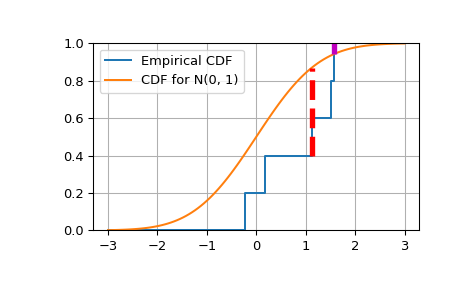scipy.special.smirnov#
- scipy.special.smirnov(n, d, out=None) = <ufunc 'smirnov'>#
Kolmogorov-Smirnov complementary cumulative distribution function
Returns the exact Kolmogorov-Smirnov complementary cumulative distribution function,(aka the Survival Function) of Dn+ (or Dn-) for a one-sided test of equality between an empirical and a theoretical distribution. It is equal to the probability that the maximum difference between a theoretical distribution and an empirical one based on n samples is greater than d.
- Parameters
- nint
Number of samples
- dfloat array_like
Deviation between the Empirical CDF (ECDF) and the target CDF.
- outndarray, optional
Optional output array for the function results
- Returns
- scalar or ndarray
The value(s) of smirnov(n, d), Prob(Dn+ >= d) (Also Prob(Dn- >= d))
See also
smirnoviThe Inverse Survival Function for the distribution
scipy.stats.ksoneProvides the functionality as a continuous distribution
kolmogorov,kolmogiFunctions for the two-sided distribution
Notes
smirnovis used by stats.kstest in the application of the Kolmogorov-Smirnov Goodness of Fit test. For historial reasons this function is exposed in scpy.special, but the recommended way to achieve the most accurate CDF/SF/PDF/PPF/ISF computations is to use the stats.ksone distribution.Examples
>>> from scipy.special import smirnov
Show the probability of a gap at least as big as 0, 0.5 and 1.0 for a sample of size 5
>>> smirnov(5, [0, 0.5, 1.0]) array([ 1. , 0.056, 0. ])
Compare a sample of size 5 drawn from a source N(0.5, 1) distribution against a target N(0, 1) CDF.
>>> from scipy.stats import norm >>> rng = np.random.default_rng() >>> n = 5 >>> gendist = norm(0.5, 1) # Normal distribution, mean 0.5, stddev 1 >>> x = np.sort(gendist.rvs(size=n, random_state=rng)) >>> x array([-1.3922078 , -0.13526532, 0.1371477 , 0.18981686, 1.81948167]) >>> target = norm(0, 1) >>> cdfs = target.cdf(x) >>> cdfs array([0.08192974, 0.44620105, 0.55454297, 0.57527368, 0.96558101]) # Construct the Empirical CDF and the K-S statistics (Dn+, Dn-, Dn) >>> ecdfs = np.arange(n+1, dtype=float)/n >>> cols = np.column_stack([x, ecdfs[1:], cdfs, cdfs - ecdfs[:n], ecdfs[1:] - cdfs]) >>> np.set_printoptions(precision=3) >>> cols array([[-1.392, 0.2 , 0.082, 0.082, 0.118], [-0.135, 0.4 , 0.446, 0.246, -0.046], [ 0.137, 0.6 , 0.555, 0.155, 0.045], [ 0.19 , 0.8 , 0.575, -0.025, 0.225], [ 1.819, 1. , 0.966, 0.166, 0.034]]) >>> gaps = cols[:, -2:] >>> Dnpm = np.max(gaps, axis=0) >>> print('Dn-=%f, Dn+=%f' % (Dnpm[0], Dnpm[1])) Dn-=0.246201, Dn+=0.224726 >>> probs = smirnov(n, Dnpm) >>> print(chr(10).join(['For a sample of size %d drawn from a N(0, 1) distribution:' % n, ... ' Smirnov n=%d: Prob(Dn- >= %f) = %.4f' % (n, Dnpm[0], probs[0]), ... ' Smirnov n=%d: Prob(Dn+ >= %f) = %.4f' % (n, Dnpm[1], probs[1])])) For a sample of size 5 drawn from a N(0, 1) distribution: Smirnov n=5: Prob(Dn- >= 0.246201) = 0.4713 Smirnov n=5: Prob(Dn+ >= 0.224726) = 0.5243
Plot the Empirical CDF against the target N(0, 1) CDF
>>> import matplotlib.pyplot as plt >>> plt.step(np.concatenate([[-3], x]), ecdfs, where='post', label='Empirical CDF') >>> x3 = np.linspace(-3, 3, 100) >>> plt.plot(x3, target.cdf(x3), label='CDF for N(0, 1)') >>> plt.ylim([0, 1]); plt.grid(True); plt.legend(); # Add vertical lines marking Dn+ and Dn- >>> iminus, iplus = np.argmax(gaps, axis=0) >>> plt.vlines([x[iminus]], ecdfs[iminus], cdfs[iminus], color='r', linestyle='dashed', lw=4) >>> plt.vlines([x[iplus]], cdfs[iplus], ecdfs[iplus+1], color='m', linestyle='dashed', lw=4) >>> plt.show()
